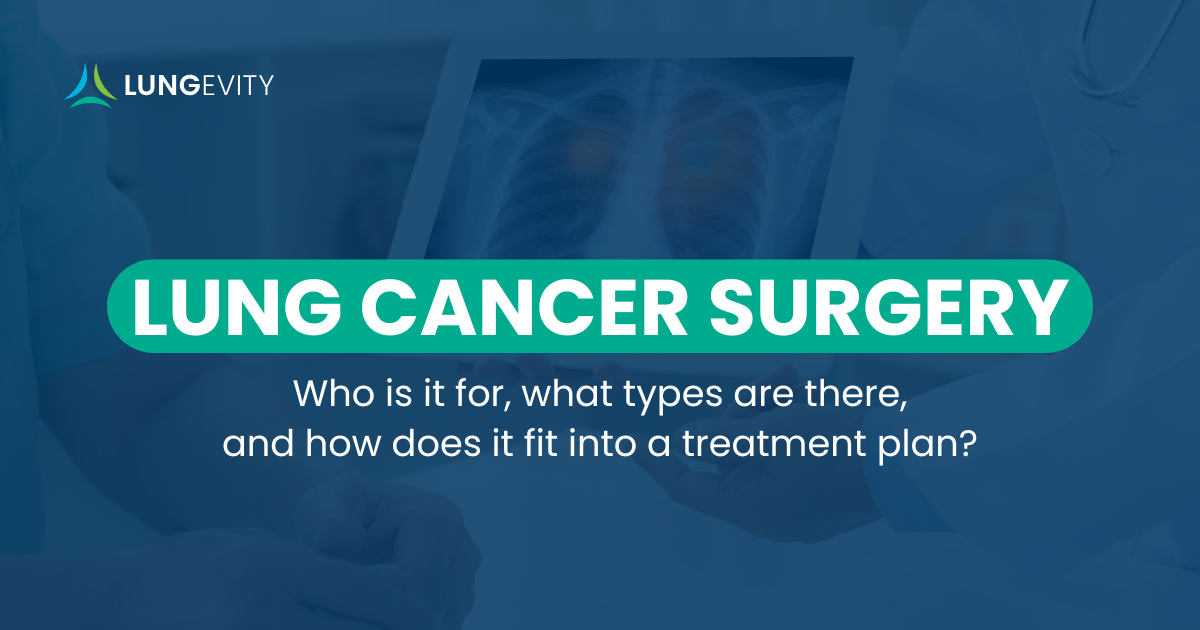Surgery is a treatment option for early-stage lung cancer that involves removing all or part of a lung to treat a cancerous tumor. It is primarily an option for people with non-small cell lung cancer (NSCLC) staged at I, II, or IIIA. Surgery is rarely considered for tumors at stage IIIB or IV because those lung cancers have spread to other parts of the body. It is also rarely used to treat small cell lung cancer (SCLC) because SCLC is typically diagnosed at a later stage.
Types of Lung Cancer Surgery
Once the medical team decides someone’s lung cancer is resectable (able to be removed by surgery), the team will recommend a specific type of lung cancer surgery. There are several surgical options.
Lobectomy
A lobectomy is the most effective and commonly used lung cancer surgery and involves removing an entire lung lobe that is affected by a cancerous tumor. In total, the human body has five lung lobes, two in the left lung and three in the right.
Wedge Resection
A wedge resection is commonly recommended to treat the smallest of lung cancer tumors, 2 cm or less in diameter, that are located in the peripheral, or outer, region of the lung. This surgery involves removing a small triangle-shaped portion of the lung where the tumor is located, along with a small amount of healthy tissue.
Segmentectomy
Each lung lobe has multiple segments, and a segmentectomy is when surgery is used to remove one of these segments. Similar to a wedge resection, a segmentectomy is only recommended for removing small tumors, 2 cm or less in diameter. The medical team will also consider the location of the tumor when choosing this surgical option.
Pneumonectomy
When a cancerous tumor is very large or close to the center of the chest, a pneumonectomy is used to remove the entire lung that is affected. This is a rare type of lung cancer surgery.
Visit this webpage to learn more about the risks and side effects of lung cancer surgery, recovery expectations, and the different techniques used.
Who Should Get Lung Cancer Surgery?
Deciding if surgery is an option starts by identifying where the cancerous tumor is located and its stage. If the lung cancer is caught at stage I, II, or IIIA, additional factors the medical team considers include:
- Can the person with cancer tolerate the operation and recover from it?
- What type of surgery would be the most effective?
- What are the results of additional testing, such as a CT scan, PET scan, endobronchial ultrasound (EBUS), and brain MRI?
Lung Cancer Treatment in Addition to Surgery
When surgery is an option for treating someone’s lung cancer, the medical team may consider combining surgery with an additional type of treatment to increase the likelihood of success. This could include chemotherapy, radiation therapy, targeted therapy, or immunotherapy. The team will also make recommendations about the best timing for these additional treatments. They can be done:
- Before surgery (neoadjuvant)
- After surgery (adjuvant)
- Both before and after surgery (periadjuvant)
Surgery for Lung Cancer: Options for Improving Outcomes
LUNGevity and Johns Hopkins Medicine partnered to host a webinar with Stephen R. Broderick, MD, MPHS, thoracic surgeon at Johns Hopkins. In the video below, Dr. Broderick goes in depth on the topics explained above and covers all things lung cancer surgery.
Topics discussed include:
- How are tumors staged and how does that affect surgery? Starts at 8:30
- What are the different types of lung cancer surgery? Starts at 12:55
- How to treat locally-advanced NSCLC. Starts at 21:20
- Improving recovery through rehabilitation. Starts at 39:30
- When is surgery an option for stage IV lung cancer? Starts at 44:00
- Audience Q&A. Starts at 51:30

